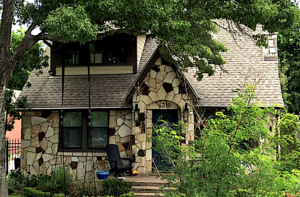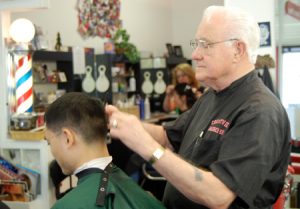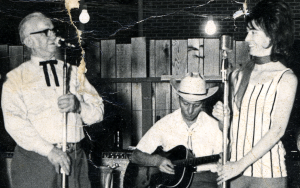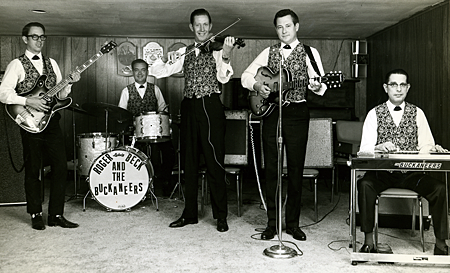Copyright 2016-2022 Susan Burneson. All rights reserved. Kindly talk with us before reproducing any content you find on the website.
Austinites Kenneth Threadgill and Roger Beck shared a deep connection to our neighborhood, as well as a long friendship and dedication to Texas music.
In 1933, Threadgill’s opened at 6302 Georgetown Road, also known then as the Dallas Highway, north of the Austin city limits. Today, that address is 6416 North Lamar in the Brentwood neighborhood. Owner Kenneth Threadgill loved music. He sang, danced, and learned to yodel as a young man, inspired by music legend Jimmie Rodgers. For more than 40 years, Threadgill performed at the club and encouraged other musicians, including Janis Joplin, who first sang there in the early 1960s. Joplin made her last appearance in Austin in July 1970, when she and Threadgill sang and danced before a large crowd for his 61st birthday; three months later she died at age 27. He closed Threadgill’s in 1974 after the death of his wife, Mildred.
Kenneth Threadgill died in 1987. He and Janis Joplin—along with Stevie Ray Vaughan, Townes Van Zandt, and a handful of others—were inducted into the Austin Music Memorial in 2010. For his contributions as a musician and supporter of the local music scene, Threadgill has been called “a unifier of Austin’s past and present” and “the father of Austin country music.” For more than 80 years, Threadgill’s was described as “a cultural touchstone for the city.”
Eddie Wilson, original owner of the iconic Armadillo World Headquarters (AWHQ) in downtown Austin, bought Threadgill’s and reopened it in 1981. For almost 40 years, it was a restaurant, bar, and music venue, filled with memorabilia from the original Threadgill’s and other Austin landmarks. Wilson’s second restaurant location, Threadgill’s World Headquarters, near the original AWHQ downtown, opened in 1996 and closed in 2018.
On April 19, 2020, Eddie Wilson made it official: He was selling Threadgill’s. A month earlier it had temporarily closed due to the COVID-19 pandemic. By October 1, 2020, the property had been sold, and plans were made to demolish the main structure, to make way for new apartments. By late June 2022, the Austin Historic Landmark Commission had denied the developer’s initial request to demolish the entire Threadgill’s building. The part that housed the original service station will be preserved.
 On January 25, 2021, the Austin Historic Landmark Commission announced that Kenneth and Mildred Threadgill’s home at 4310 Rosedale, right, in the Rosedale neighborhood of Austin, was approved to become a historic landmark. The home, built in the late 1930s, has a stone facade similar in style to the work of Frank B. Wright, an Austin stonemason during that time.
On January 25, 2021, the Austin Historic Landmark Commission announced that Kenneth and Mildred Threadgill’s home at 4310 Rosedale, right, in the Rosedale neighborhood of Austin, was approved to become a historic landmark. The home, built in the late 1930s, has a stone facade similar in style to the work of Frank B. Wright, an Austin stonemason during that time.
The video clip below is from our film A Community Mosaic, narrated by Brentwood neighbor Howard Bennett. It features early images and history of Threadgill’s, as well as a mosaic of the original building created by Jean Graham for her Wall of Welcome.
 Kenneth Threadgill’s longtime friend Roger Beck, right, was a barber for almost 61 years and a musician for 72 years. (Photo taken by Rob Burneson in 2004.)
Kenneth Threadgill’s longtime friend Roger Beck, right, was a barber for almost 61 years and a musician for 72 years. (Photo taken by Rob Burneson in 2004.)
Regulars at Crestview Barber Shop often would sit and visit while they waited for Beck’s chair to open up. Some of them went to him for many years. One barber at the shop said he never saw anyone but Beck do a freehand flat-top haircut, and he did it easily and well. Not many barbers do a flat-top cut anymore, and, if they do, many of them rely instead on a special flat-topper comb, to make sure the cut is straight. (More about Crestview Barber Shop and other businesses in Crestview Shopping Center here.)
 Beck’s late wife Margie also was friends with Kenneth Threadgill for many years; she sang with him at one time. The photo, left, shows them likely at the Split Rail, a popular South Austin music venue until sometime in the 70s. It was located roughly across from where Toomey Drive meets South Lamar. Beck remained Threadgill’s good friend and barber until Threadgill died in 1987.
Beck’s late wife Margie also was friends with Kenneth Threadgill for many years; she sang with him at one time. The photo, left, shows them likely at the Split Rail, a popular South Austin music venue until sometime in the 70s. It was located roughly across from where Toomey Drive meets South Lamar. Beck remained Threadgill’s good friend and barber until Threadgill died in 1987.
In 2004, Beck shared with me stories of musicians he had known, as well as his music scrapbook, which included the photo below. He’s at the mike playing rhythm guitar with his group the Buckaneers; the group’s drum art is a mosaic on the Wall of Welcome.
 Beck always admired musician Eldon Shamblin. Known as one of the first electric guitarists in a popular dance band, he once was described by Rolling Stone magazine as “the world’s greatest rhythm guitar player.”
Beck always admired musician Eldon Shamblin. Known as one of the first electric guitarists in a popular dance band, he once was described by Rolling Stone magazine as “the world’s greatest rhythm guitar player.”
Shamblin joined Bob Wills and His Texas Playboys in the mid-1930s and performed with the group for many years. He later toured and recorded with Merle Haggard, Asleep at the Wheel, and others.
Roger Beck performed with many other legendary Texas musicians, too, including fiddle players Johnny Gimble, Leon “Pappy” Selph, and Cotton Collins; vocalist Leon Rausch; and steel guitarist Herb Remington.
In 2005, Beck was inducted into the Texas Western Swing Hall of Fame. Beck and his band continued to perform throughout Central Texas—including at our neighborhood’s Violet Crown Festival and Violet Crown Arts Festival—until two months before he died at age 84 on September 26, 2016.
To learn more about the musicians featured in this blog post, click on the names below.
Roger Beck • Kenneth Threadgill • Bill Neely • Eldon Shamblin • Bob Wills and His Texas Playboys • Johnny Gimble • Leon “Pappy” Selph • Cotton Collins and his Westphalia Waltz • Leon Rausch • Herb Remington
And, stay tuned for more Voices of the Violet Crown!
